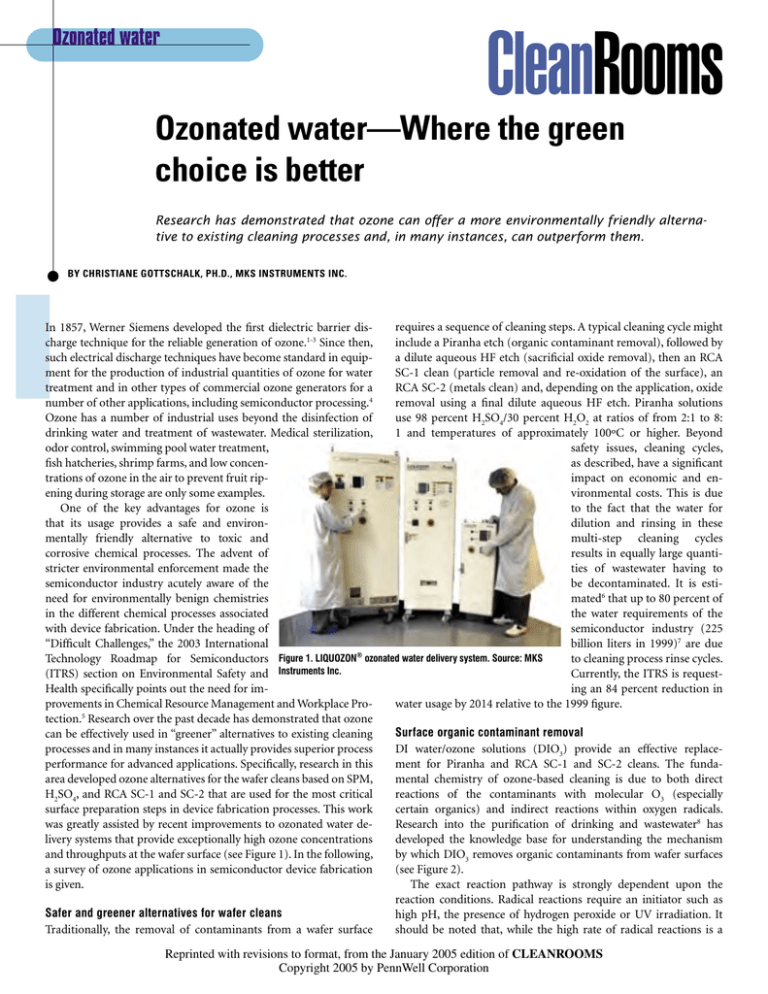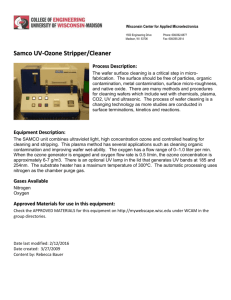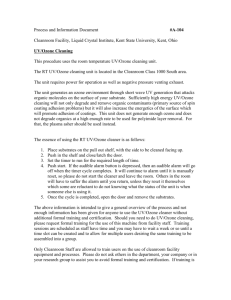Ozonated water—Where the green choice is better
advertisement

Ozonated water Ozonated water—Where the green choice is better Research has demonstrated that ozone can offer a more environmentally friendly alternative to existing cleaning processes and, in many instances, can outperform them. I BY CHRISTIANE GOTTSCHALK, PH.D., MKS INSTRUMENTS INC. requires a sequence of cleaning steps. A typical cleaning cycle might In 1857, Werner Siemens developed the first dielectric barrier dis1-3 include a Piranha etch (organic contaminant removal), followed by charge technique for the reliable generation of ozone. Since then, such electrical discharge techniques have become standard in equipa dilute aqueous HF etch (sacrificial oxide removal), then an RCA ment for the production of industrial quantities of ozone for water SC-1 clean (particle removal and re-oxidation of the surface), an treatment and in other types of commercial ozone generators for a RCA SC-2 (metals clean) and, depending on the application, oxide number of other applications, including semiconductor processing.4 removal using a final dilute aqueous HF etch. Piranha solutions Ozone has a number of industrial uses beyond the disinfection of use 98 percent H2SO4/30 percent H2O2 at ratios of from 2:1 to 8: 1 and temperatures of approximately 100ºC or higher. Beyond drinking water and treatment of wastewater. Medical sterilization, safety issues, cleaning cycles, odor control, swimming pool water treatment, as described, have a significant fish hatcheries, shrimp farms, and low concenimpact on economic and entrations of ozone in the air to prevent fruit ripvironmental costs. This is due ening during storage are only some examples. to the fact that the water for One of the key advantages for ozone is dilution and rinsing in these that its usage provides a safe and environmulti-step cleaning cycles mentally friendly alternative to toxic and results in equally large quanticorrosive chemical processes. The advent of ties of wastewater having to stricter environmental enforcement made the be decontaminated. It is estisemiconductor industry acutely aware of the mated6 that up to 80 percent of need for environmentally benign chemistries the water requirements of the in the different chemical processes associated semiconductor industry (225 with device fabrication. Under the heading of billion liters in 1999)7 are due “Difficult Challenges,” the 2003 International ® Figure 1. LIQUOZON ozonated water delivery system. Source: MKS to cleaning process rinse cycles. Technology Roadmap for Semiconductors Currently, the ITRS is request(ITRS) section on Environmental Safety and Instruments Inc. ing an 84 percent reduction in Health specifically points out the need for imwater usage by 2014 relative to the 1999 figure. provements in Chemical Resource Management and Workplace Protection.5 Research over the past decade has demonstrated that ozone Surface organic contaminant removal can be effectively used in “greener” alternatives to existing cleaning DI water/ozone solutions (DIO3) provide an effective replaceprocesses and in many instances it actually provides superior process ment for Piranha and RCA SC-1 and SC-2 cleans. The fundaperformance for advanced applications. Specifically, research in this mental chemistry of ozone-based cleaning is due to both direct area developed ozone alternatives for the wafer cleans based on SPM, reactions of the contaminants with molecular O3 (especially H2SO4, and RCA SC-1 and SC-2 that are used for the most critical surface preparation steps in device fabrication processes. This work certain organics) and indirect reactions within oxygen radicals. was greatly assisted by recent improvements to ozonated water deResearch into the purification of drinking and wastewater8 has developed the knowledge base for understanding the mechanism livery systems that provide exceptionally high ozone concentrations by which DIO3 removes organic contaminants from wafer surfaces and throughputs at the wafer surface (see Figure 1). In the following, (see Figure 2). a survey of ozone applications in semiconductor device fabrication The exact reaction pathway is strongly dependent upon the is given. reaction conditions. Radical reactions require an initiator such as Safer and greener alternatives for wafer cleans high pH, the presence of hydrogen peroxide or UV irradiation. It Traditionally, the removal of contaminants from a wafer surface should be noted that, while the high rate of radical reactions is a Reprinted with revisions to format, from the January 2005 edition of CLEANROOMS Copyright 2005 by PennWell Corporation Ozonated water have shown that the rate-limiting step of DIO3 photoresist stripping is mass transfer of molecular ozone to the wafer surface.9 Thus, techniques that overcome boundary layer limitations can enhance strip rates (e.g., megasonic agitation or the use of vapor phase ozone-water vapor mixtures).10, 11 The best process results for photoresist strip are achieved through the use of physical optimization of ozone mass transport mechanisms coupled with the highest possible ozone concentrations and optimum process temperature. ������ �� ����� �������� ��������� �� ������ ���������� ��� ���� �������� ���� �� �� ���� ���� ����� �������� ���� �� �� ��� ����������� ���������� � Figure 2. Ozone reaction schematic.8 ������������������� desirable trait for surface cleans, conditions that promote only radical chemistries can be problematic. Radical species are highly reactive and have very short half-lives. As a consequence, radicals that are generated too far away from the wafer surface react out of the system before they can reach that surface and interact with the contaminants. This characteristic has obvious consequences for reactant depletion and probably loss of uniformity in the cleaning process. Photoresist removal Processes for the removal of photoresist residues are closely related to those for the removal of organic surface contamination. Traditionally, wet chemical processes for photoresist removal are based on Piranhalike solutions of sulfuric acid with either hydrogen peroxide (SPM) or ozone (SOM). Recent emphasis on reduced cost of ownership and improved performance has engendered interest in the development of ozonated DI water-based processes to replace these processes. Studies have shown that DIO3 solutions are effective for photoresist strip, albeit with certain limitations. Photoresist removal rates are proportional to the ozone concentration and to the process temperature. Elevated temperatures enhance the strip rate but the solubility and stability of ozone decreases rapidly with temperature causing a fast decay of dissolved ozone concentrations at higher temperatures. Studies Cleaning metal and particle contamination DIO3 by itself is not chemically suited to clean metals or particles directly from a wafer surface except in the case of particles that are organic in nature (Fe, Ni, Al, Mg, Ca, etc., are typically present on wafer surfaces as oxides or hydroxides). Conventionally, metals and inorganic particles are removed by directly etching an underlying silicon dioxide layer to “lift” the particles away from the surface, typically using dilute HF (dHF), followed by rapid removal of the freed particle from the vicinity of the surface. DIO3 can remove particulates in a similar fashion through its ability to oxidize the wafer surface and produce a layer that is suitable for HF etching. The thickness of the oxide layer formed by DIO3 is self-limited, typically about 1 nm thick. Parameters like ozone concentration and pH have been shown to influence the oxide growth rate.15 The sequential applications of aqueous acid and ozone solutions can be very effective in cleaning metals and particulates from wafer ������ �� �������� ��� ������ ������ ��� ��� ��������� �������� ����� ������ Figure 3. A schematic drawing showing the ASTEC ������������������� dHF/O3 cleaning and drying system. surfaces.11, 12-15, 19 Single wafer Spin Cleaning with Repetitive use of Ozonated water and Dilute HF (SCROD), developed by workers at Sony, alternately dispenses dHF and DIO3 on a spinning wafer.16 A typical one-minute, three-cycle SCROD clean can remove 87 percent of Al2O3 particles, 97 percent of Si3N4 particles and 99.5 percent of polystyrene latex particles19 without significant surface roughening. Advanced Cleaning and Drying (ACD), developed by ASTEC in Germany, uses a similar sequential approach (see Figure 3). ACD gives results comparable to a standard RCA clean, but with significantly reduced chemicals consumption (up to 60 percent less chemical usage). The wafer can be easily re-oxidized in the atmosphere above the dHF/O3 bath. A comparison of metal contamination on an Si (100) surface after a) one HF/O3 cycle, b) a modified RCA clean, and c) an alkaline etch shows that metal contamination levels < 1 x 109 can be achieved using dHF/O3.17 These applications have been successful with non-structured and lightly structured wafers.18 Advanced reticle cleaning Advanced reticles use phase shifting to increase resolution without reducing the wavelength of the light used to produce the lithographic image. Traditionally, reticles have been cleaned using conventional Piranha and RCA approaches. Recently, reports have shown that repeated application of these cleaning methods produces unacceptable variation in phase shift angle and transmittance in advanced masks.20 Studies at the 180 nm technology node showed that reticles could only be cleaned two to eight times before unacceptable degradation in the optical properties occurred.21 Optical degradation is directly related to the degree to which the mask is etched and its surface roughened. As was noted in previous sections, ozone-based etch chemistries result in very little surface roughening. These chemistries are therefore becoming preferred for reticle cleaning. It is also noteworthy that for heavy polymer removal, such as in photoresist strip, the most efficient processes are only realized at high ozone throughputs. Processes such as these therefore require high flow ozone systems. DIO3 etch processes and new equipment configurations Single wafer processing has three main goals: Ozonated water ������ �� �������� ������ ����� ���������� �������� ����������� �� ��������� ����� ��� �� � �� �� �� � � ��������� ���� ����������� ��� ����� ��������� ���� ������ ��� ����� ����� ����� �� ������� ����� ����� �� ������ �������� ������ cleans in device fabrication is driven by enhanced process requirements, economics, environmental impact and safety aspects. Various green alternatives to these processes have emerged in recent years, all based on the replacement of the oxidizers with ozone. O3-based processes have been shown to improve performance while involving fewer steps, reduced chemical consumption, and lower costs. III ����� �� ����� ����������� ����� ��� �������� �������� ��� �������� ����� ����� ���������� ��� ����� ��� ������� ��� ��� ��� � ��������� ���� ����������� ��� ����� ��������� ���� ������ ��� ����� ����� ����� �� ������� ����� ����� �� ������ Christiane Gottschalk, Ph.D., is the ozone product manager of MKS Instruments, ASTeX, and has worked in the company’s office in Berlin, Germany, since 1997. She has published several papers and two books on ozone. She can be reached via e-mail at cgottschalk@astex.mksinst.com. �������� ������ ������������������� Figure 4. Chemical and DI-water usage of different cleaning methods. Source: T. Hattori, 2003 better process control; cost reduction; and reduced environmental impact. The control of reagent flows and purities, as well as more effective effluent handling, improves as the rapid removal of reaction products from near the wafer surface becomes possible. Single wafer configurations generally yield improvements in etch uniformities within wafer, wafer-to-wafer and lot-to-lot. Finally, fab economics and fab line flexibility are aided by the reduced footprint of single wafer systems vs. immersion systems. The use of ozonated water in single wafer processes requires relative low flow rates per chamber (1 to 2 L/min) and a very controlled dissolved ozone concentration to ensure repeatable process results. Workers at Sony19 have shown that SCROD cleaning in a single wafer spin cleaning tool uses far less cleaning chemicals and rinse water than immersion RCA cleans (see Figure 4). The need to replace Piranha and RCA References 1. W. Siemens, Poggendorff’s Annalen der Physik Chemie, 102, 66 (1857); cited in ref. 2. 2. U. Kogelschatz, “Dielectric-barrier discharges: Their history, discharge physics, and industrial applications,” Plasma Chemistry and Plasma Processing, Vol. 23, No. 1, March 2003. 3. U. Kogelschatz, B. Eliasson and W. Egli, “From ozone generators to flat television screens: History and future potential of dielectric-barrier discharges,” Pure and Applied Chemistry, Vol. 71, No. 10, 1999:1819-1828. 4. ASTeX® Ozone Product Line, MKS Instruments Inc., Wilmington, MA, http: //www.mksinst.com/PRG3.html. 5. Semiconductor Industry Association, The International Technology Roadmap for Semiconductors, San Jose, 2003; available at http: //public.itrs.net/Files/2003ITRS/Home2003.htm. 6. P. H. Gleick, D. Haasz, C. Henges-Jeck, V. Srinivasan, G. Wolff, K. Kao Cushing, and A. Mann, Waste Not, Want Not: The Potential for Urban Water Conservation in California, The Pacific Institute, San Jose, November 2003; available at http://www.pacinst.org/reports/ urban_usage/waste_not_want_not_full_ report.pdf. 7. P. Burggraaf, “A Closer Look at the Most Diffi- cult Process Challenges,” Solid State Technology, September 2000. 8. C. Gottschalk, A. Libra and A. Saupe, Ozonation of Water and Waste Water—A Practical Guide to Understanding Ozone and Its Applications, Weinheim Germany: Wiley-VCH, 2000. 9. S. De Gendt, J. Wauters and M. Heyns, “A Novel Resist and Post-Etch Residue Removal Process Using Ozonated Chemistry,” Solid State Technology, Vol. 41, No. 12, 1998: 57-60. 10. H. Abe, H. Iwamoto, T. Toshima, T. Iino and G. W. Gale, “ Novel photoresist stripping technology using ozone/vaporized water mixture,” IEEE Transactions on Semiconductor Manufacturing, Vol. 16, No. 3, August 2003: 401-408. 11. S. De Gendt et al., “A Novel Resist and PostEtch Residue Removal Process Using Ozonated Chemistry,” Solid State Phenomena, Vol. 65-66, 1999: 165-168. 12. E. D. Olson et al., “Alternatives to Standard Wet Cleans,” Semiconductor International, Vol. 23, No. 9, 2000: 70-76. 13. E. Bergman and S. Lagrange, “HF-Ozone Cleaning Chemistry,” Solid State Technology, Vol. 46, No. 7, 2001: 115-124. 14. M. Alessandri et al., “Particle Removal Efficiency and Silicon Roughness in HF-DIW/O3 /Megasonics Cleaning,” Solid State Phenomena, Vol. 65-66, 1999: 27-30. 15. T. Ohmi, “Total Room Temperature Wet Cleaning of Silicon Surfaces,” Semiconductor International, Vol. 19, No. 8, 1996: 323-338. 16. T. Hattori, T. Osaka, A. Okamoto, K. Saga and H. Kuniyasu, “Contamination Removal by Single-Wafer Cleaning with Repetitive Use of Ozonated Wafer and Dilute HF,” J. Electrochem. Soc., Vol. 145, No. 9, 1998: 3278-3284. 17. C. Gottschalk, J. Schweckendiek, “Using dissolved ozone in semiconductor cleaning applications,” Micro, March 2004: 81. 18. C.V. Ciufia, K.G. Knoch, J. Osterkamp, “Metal Removal and Drying by HF/O3,” abstract. Technical paper presented at Semiconductor Wet Processing Conference, 2004, available at: http: //www.spwcc.com/abstracts_list.htm. 19. T. Hattori, “Implementing a Single-Wafer Cleaning Technology Suitable for Minifab Operations,”Micro, Vol. 21, No. 1, 2003: 49-57. 20. I. Kashkoush, G. Chen and R. Novak, “Today’s binary and EAPSMs need advanced mask cleaning methods,” Solid State Technology, Vol. 47, No. 2, February 2004. 21. A. Hand, “Getting Masks Clean With Minimal Optical Degradation,” Semiconductor International, Vol. 26, No. 11, October 2003. ���� ������� ������������ ���� ������ ���� ��� ����������� ��� ������������ ��� ���������� ������������ ����� �������� �������� ������� ���� ������������ ���� ������������� ���� ������� ���� ��������������� ���� ���������������



